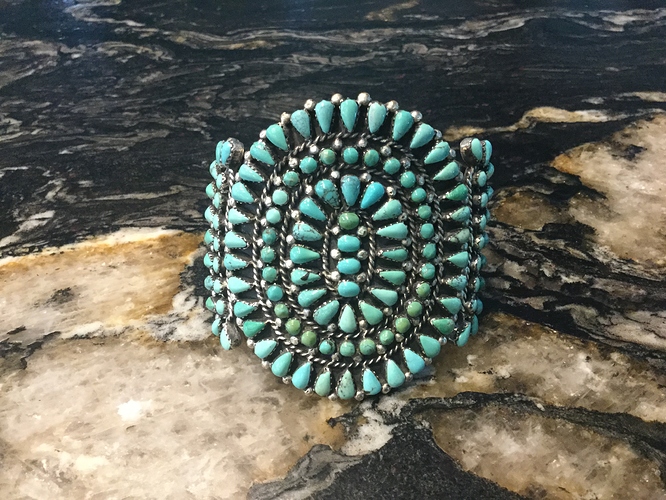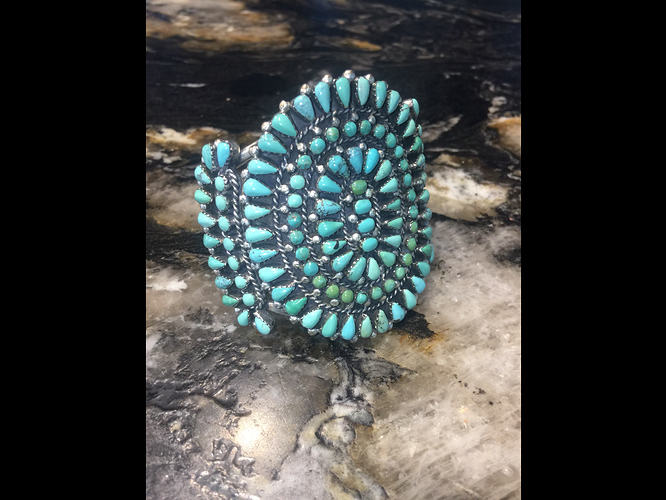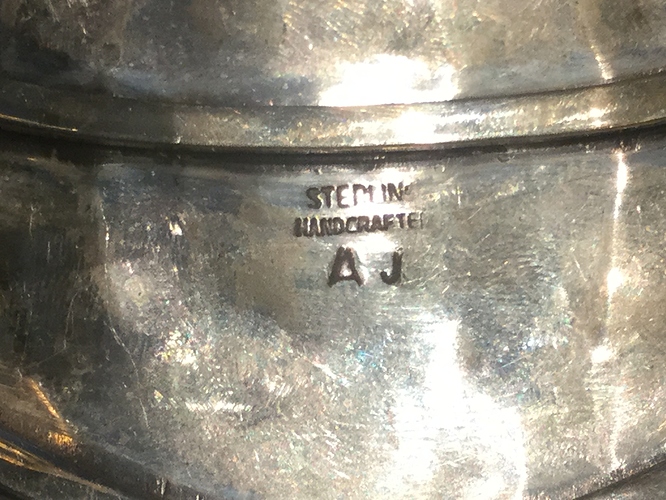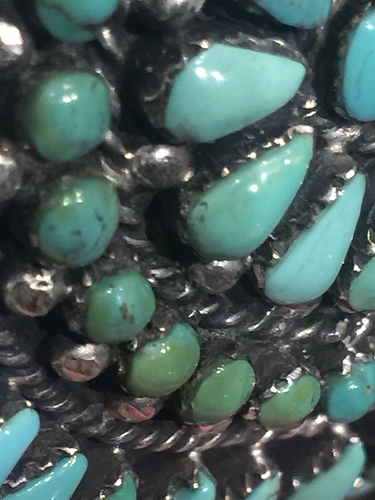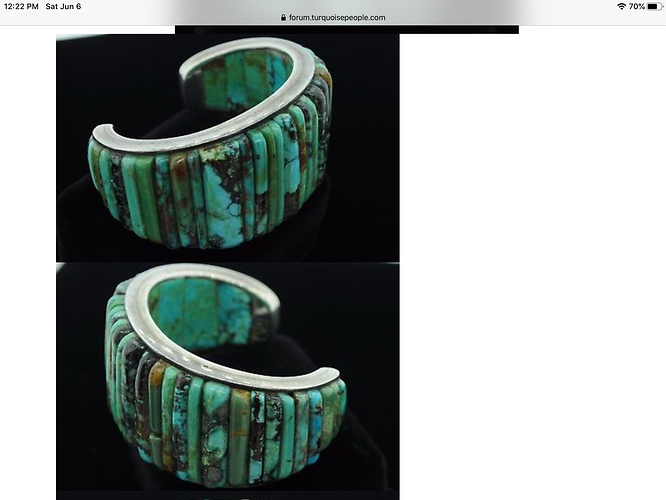Got this Petit Point Bracelet awhile back. I’m thinking it is Navajo made. Wondering if there is different types of turquoise or it’s changing colors with age, Could not find anything on the hallmark but found a similar cuff with the same hallmark but it was not identified. Any info on the bracelet or turquoise is appreciated. Thanks
Looks Zuni, but probably isn’t. I worked for many years in and around Zuni Pueblo buying jewelry directly from Zuni craftspeople. Have never seen “handcrafted” stamped on a genuine Zuni piece, since legally, most Zuni is completely handmade. Also, the stones aren’t typical of the clear blue Sleeping Beauty turquoise Zuni craftspeople have used for decades. Some of the stones show matrix typical of treated cake turquoise, and others show matrix typical of Asian turquoise. Many of the stones appear to be mismatched and possibly from different mines. This isn’t Zuni work.
The style (if not the manufacture) is 100% Zuni.
No way this is Navajo, or likely even made in the US. Best guess would be a copy piece made in the Philippines.
Thanks @mmrogers for your quick reply. I did notice and put in my post that it looked like the turquoise could be from different mines. I hadn’t thought of the possibility of block turquoise being used. At your suggestion, I tried many of the stones, varying colors, with a hot needle test and there was no reaction to the heat what so ever. Posting a close up picture on the turquoise. I don’t believe there is block in this piece. What are your thoughts on the new uploaded pictures? I really appreciate your help. Thanks again.
Hi Currada. The type of test you’re discussing is hit and miss as simply touching a hot needle to the surface of a stone wouldn’t necessarily cause a visible reaction. Back when I was doing market inspections for IACA (with the owners permission) I would have taken one or more of the sample stones out and examined them through a 10X loupe, and then reset the stone.
With a larger stone, one can sometimes very very briefly and gently heat the surface of the stone (really just gently passing the flame over) with a lighter or soft torch flame to see if a telltale ‘plastic’ smell is present. With a smaller stone like the ones in the above referenced bracelet, I wouldn’t attempt this. Also, this doesn’t work for all chemically treated stones, just the ones enhanced by acrylic stabilization. Even with a larger stone, there’s a risk of damaging the surface of the stone, so not recommended in this particular circumstance unless you have a replacement stone handy, or can cut one to match.
“Looks like” and “might be” are not definite statements, and its impossible to know for sure without direct physical examination of the stones themselves.
Regardless of the origin, most of the work in the bracelet, and perhaps all of it is completely hand fabricated (hand made). The only exception might be the shank, and once again, to know with certainty one would have to examine it up close and in person. The stones are cut individually to a template in the same way and fashion as in Zuni Pueblo.
From a technical perspective, this is a very nice example of an (at least mostly) handmade bracelet in a classic Zuni Petit Point style. All in all It’s a a beautiful piece of jewelry.
Hi @mmrogers. Thanks for all the great info. I did loupe my piece and found host rock in some of the stones that I was able to feel when running my hand over. I found another bracelet with the same hallmark currently for sale at a shop online. It has the same use of mixed stones.
Hi Currada.
Good watching out! This looks like an excellent example of exactly what we were discussing.
Beyond the mismatched turquoise stones which are obviously asian in origin, one of the things that jumps out to me with this piece is the areas of formerly serrated bezel - outer row of stones, top left hand - which have been buffed down smooth around the edges.
I suspect that to save time the stones were set semi-finished, and polished down at the same time the bracelet went through the pre-finishing step, usually done with deep cutting “white diamond” or yellow bobbing compound.
Whoever did the finishing on this one was pretty sloppy with that process, and buffed away the upper serrated portion of the bezel on some of the stones. This is why you see a few of the stones set in bezels with smooth edges, while others have intact serrated edge bezels.
I am SO impressed with your knowledge mmrogers! I will be looking for your comments on this site from now on… not stalking you lol. My only two cents is that I think the mixed stones and colors used in the piece makes it really rich and interesting to look at. I’d like to see it done more often.
Hi @sandy,
I agree with you. I have this cornrow bracelet that I posted way back. It is by no means my most expensive piece but I love the mix of American and Chinese turquoise. It’s one of my favorites.
Your cornrow cuff is really beautiful! I have never seen one before. The mix of turquoise makes the piece. I can see why you like wearing it! Thanks for posting it.
That’s a beautiful bracelet, is it heavy?
